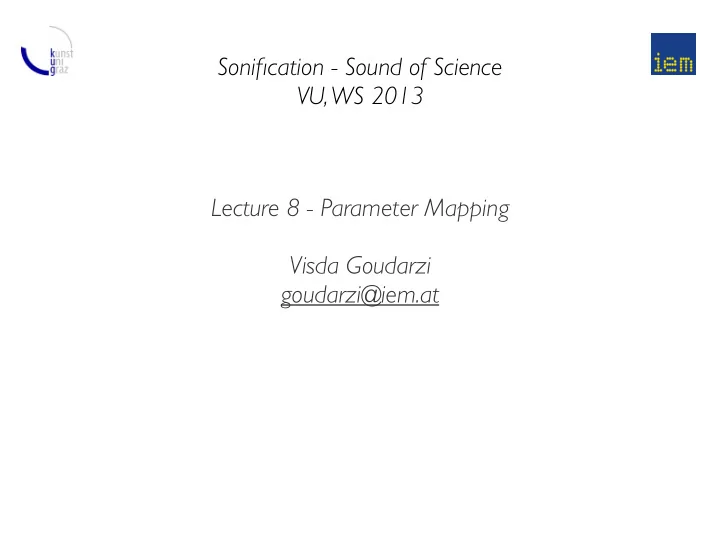

Sonification - Sound of Science VU, WS 2013 Lecture 8 - Parameter Mapping Visda Goudarzi goudarzi@iem.at
Parameter Mapping Sonification Rhythm s o und s o und Pitch Sound Sound Sound Melody sound usodn Timbre sound sound sound Parameter Data - mapping Dimensions sound Location sound sound sound sound sound sound sound s o u n d So u n d Loudness ... Sonification - Sound of Science VU, WS 2013
Parameter Mapping Auditory Dimension: the subjective perceptual experience of particular physical characteristic of an auditory stimulus. [Neuhoff, Sonification Handbook, p. 64] Continuous vs. Categorical dimension Mapping, Scaling, Polarity Sonification - Sound of Science VU, WS 2013
Mapping: Pitch • Logarithmic • Hearable range: 20 - 20kHz (theoretically!), bearable range: 100 - 6000 Hz. • JND (Just Noticeable Difference)- for each tone 1% (1/6th half tone), in bearable range 400 different steps • Polarity? • high temperature - high frequencies (Flowers et al. 2001) • Increasing frequency - decreasing size (Walker. 2002) Sonification - Sound of Science VU, WS 2013
Mapping: Loudness • Useful range: from 50 dB, (JND) - 0,5 - 1 dB • Generally not a good auditory dimension: • Lack of good resolution comp. to frequencies • Memory for loudness is poor • Background noise and sound reproduction equipment play a huge role -> sonification of continuous variables using loudness change is difficult [flowers] • Interaction with other perceptual dimensions such as pitch and timbre Sonification - Sound of Science VU, WS 2013
Amplitude Compensation equal loudness curve • Loudness and Pitch are not orthogonal • In SC : classes AmpComp and AmpComA Sonification - Sound of Science VU, WS 2013
Mapping: Spacialization direction and distance HRTF (head related transfer function) Binaural speakers Sonification - Sound of Science VU, WS 2013
Mapping: Timbre • Different Instruments (similar timbres can lead to confusing results due to perceptual grouping [flowers,2005] ) • Specific attributes of sound such as attack, decay, ... • Formants (vocals) (Speech class in SC) Sonification - Sound of Science VU, WS 2013
Mapping: Timbre Example: The Climate Symphony 110,000 years history of climate from Greenland's ice core: PCA (principal component analysis) of time series from 8 series to 3 • atmospheric circulation response to the growth and decay of the • continental ice sheets biological response of changing climate (recorded in the nitrate and • ammonium series) http://www.drsrl.com • Sonification - Sound of Science VU, WS 2013
Redundant Mapping More sound parameters are controlled by one Data Parameter one - to - many (divergent mapping) -> Psychoacoustic dependencies are minimized Perceptual dimensions are not one - to - one independent More sound parameters influence one many - to - one (convergent mapping) perceptual parameter. (e.g. gesture to sound) Sonification - Sound of Science VU, WS 2013
PM Sonification Process Sonification - Sound of Science VU, WS 2013
Assignment III due on Monday 25.11.2013 11:59:59 pm 1.Array manipulation: a) Make a one-dimensional array of n entries, and fill it - by hand or using any function {} b) Find its maximal and minimal value; c) Go over all entries in the array (using ".do") and post the value in the post window d) Map the values of the array linearly to the range of 200 to 1000 (which could later be used as, e.g., Hz) 2. Synth manipulation: a) change some parameters in the SynthDef and/or play with the implemented UGens 3. Sonification/ Task manipulation: a) Change the mapping somehow and play an example b) Change the timing of the task - what is a good time for listening?! 4. Evaluation: Play a mini-listening exercise to each other and find out what can be heard in a blind testing condition (polarity and magnitude estimation) Sonification - Sound of Science VU, WS 2013
Recommend
More recommend